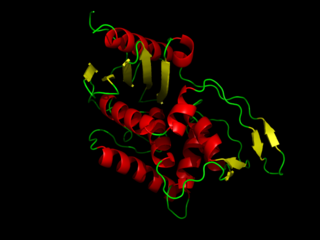| UDP-N-acetylmuramoylpentapeptide-lysine N6-alanyltransferase | |||||||||
|---|---|---|---|---|---|---|---|---|---|
| Identifiers | |||||||||
| EC no. | 2.3.2.10 | ||||||||
| CAS no. | 37257-26-4 | ||||||||
| Databases | |||||||||
| IntEnz | IntEnz view | ||||||||
| BRENDA | BRENDA entry | ||||||||
| ExPASy | NiceZyme view | ||||||||
| KEGG | KEGG entry | ||||||||
| MetaCyc | metabolic pathway | ||||||||
| PRIAM | profile | ||||||||
| PDB structures | RCSB PDB PDBe PDBsum | ||||||||
| Gene Ontology | AmiGO / QuickGO | ||||||||
| |||||||||
In enzymology, an UDP-N-acetylmuramoylpentapeptide-lysine N6-alanyltransferase (EC 2.3.2.10) is an enzyme that catalyzes the chemical reaction
- L-alanyl-tRNA + UDP-N-acetylmuramoyl-L-alanyl-D-glutamyl-L-lysyl-D-alanyl-D-alanine tRNA + UDP-N-acetylmuramoyl-L-alanyl-D-glutamyl-N6-(L-alanyl)-L-lysyl-D- alanyl-D-alanine
Thus, the two substrates of this enzyme are L-alanyl-tRNA and UDP-N-acetylmuramoyl-L-alanyl-D-glutamyl-L-lysyl-D-alanyl-D-alanine, whereas its 3 products are tRNA, UDP-N-acetylmuramoyl-L-alanyl-D-glutamyl-N6-(L-alanyl)-L-lysyl-D-, and alanyl-D-alanine.
This enzyme belongs to the family of transferases, specifically the aminoacyltransferases. The systematic name of this enzyme class is L-alanyl-tRNA:UDP-N-acetylmuramoyl-L-alanyl-D-glutamyl-L-lysyl-D-ala nyl-D-alanine N6-alanyltransferase. Other names in common use include alanyl-transfer ribonucleate-uridine, diphosphoacetylmuramoylpentapeptide transferase, UDP-N-acetylmuramoylpentapeptide lysine N6-alanyltransferase, uridine diphosphoacetylmuramoylpentapeptide lysine, N6-alanyltransferase, L-alanyl-tRNA:UDP-N-acetylmuramoyl-L-alanyl-D-glutamyl-L-lysyl-D-, and alanyl-D-alanine 6-N-alanyltransferase. This enzyme participates in peptidoglycan biosynthesis.



